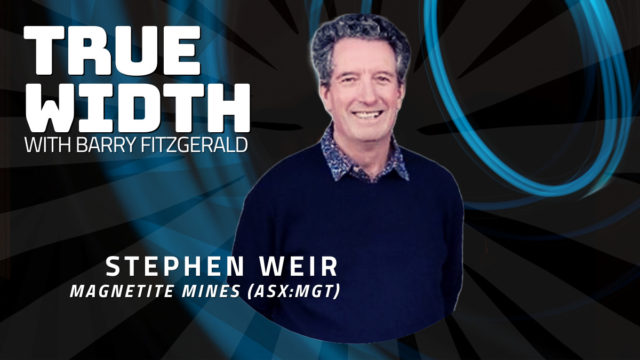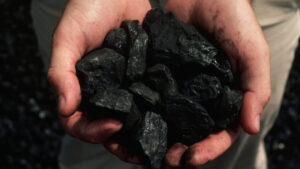Special Report: In Barry FitzGerald’s new regular column, True Width, he sits down with Australia’s leading resource and mining bosses to discuss their current projects and plans for the future.
This week Barry talks with Stephen Weir, CEO of Magnetite Mines (ASX:MGT).
Ask Magnetite Mines’ new chief executive Stephen Weir what attracted him to the high-grade iron ore developer – after a long and successful career in corporate finance – and his answer is both fun and ambitious.
“Very few people get to build an iron ore mine,” he says. “And it really excites me that we’re unlocking South Australia’s Braemar, 240km north-east of Adelaide – a whole new region.”
Weir joined Magnetite after a 25-year career in corporate finance across the mining and energy sector with RFC Ambrian, including a period as its managing director.
“Magnetite was a client of RFC Ambrian and I knew the business well. And when I was asked to come on board, I jumped at the opportunity,’’ Weir said
Early in his career, Weir applied his mechanical engineering degree from Melbourne University to building mines and mineral processing plants with John Holland.
His corporate finance/engineering background is just the skillset required at Magnetite, as it sets out to finance and build the first stage of its Razorback Iron Ore Project in the Braemar region, with first production targeted for late 2024/early 2025.
“I have been around for a while and I really view this CEO role at Magnetite as the highlightof my career,’’ Weir said.
High-grade for green steel
“The scale of the resource [Razorback contains 4.2 billion tonnes of magnetite ore] is very, very large,’’ Weir said.
“And the whole green steel story is starting to play out in a big way. And the only way that works is to use very high-grade inputs.’’
“It’s why steel mills and the big miners are chasing high grade material like that we will produce at Razorback [68% iron concentrates compared with 58-60% ores in the Pilbara],’’ Weir said.
“The whole low emissions story means the time has come for magnetite and for the Razorback project.’’
“The steel industry understands that iron grades in the Pilbara are declining. So, there is genuine interest in the high-grade magnetite concentrate that we will be producing,’’ Weir said.
Weir acknowledges that while the steel industry is switched on to the green benefits of high-grade magnetite concentrates, the Australian equities markets has been slow on the uptake.
He said that is partly due to the chequered performance of magnetite projects in Western Australia.
Lack of understanding
“To be honest, I think that there is a fair degree of cynicism in the Australian market. But that just reflects a lack of understanding on the differences between the individual projects.’’
“For instance, one of the things we are continually hammering is that we have got magnetite hosted in siltstone which requires significantly less energy to grind than is the case with the WA magnetite projects,’’ Weir said.
Razorback’s SA location also means that its green credentials are set to be enhanced by its power requirements being able to piggyback off the state’s high renewable energy penetration rates.
“That provides the project with a massive advantage,’’ Weir said.
“When we plan to be coming on-line, the renewables penetration in that part of the country is forecast to be well in excess of 90%.’’
“That’s extraordinary when you think about it – being able to power a relatively energy intensive project with green power, particularly when you look at the cost of that compared with gas-fired or diesel power they’re having to use up in the Pilbara,’’ Weir said.
Looking ahead
Weir originally joined Magnetite to manage the pre-feasibility study into the Razorback development. The PFS was completed July 2021 and Weir took on management of the definitive feasibility study now underway.
The company is fully funded to complete all of the technical and engineering aspects of the DFS after raising $15.8 million from a rights issue in May.
Weir said the DFS was about 50% complete and was due to be completed by the end of the year.
“Metallurgical test work is progressing well. The process flowsheets are being finalised, and we have nearly finished selecting all of the major items of vendor equipment, and we are starting to go out to the market for pricing.’’
Money talks
The momentum at the project has also carried over into financing discussions.
“We’ve got enough information out of our feasibility study work to start preliminary discussions with financial participants, and we have already started talking to potential joint venture partners to fund some of the equity piece,’’ Weir said.
The intention is to sell some equity in the project to a strategic partner that would enter into an offtake arrangement.
“It comes back to my statement about interest coming from the industry in our product,’’ Weir said.
“Assuming we get funding shortly after release of the DFS, we plan to be mining at the end of 2024. It’s a pretty aggressive target, but once we start receiving feedback from the vendors on equipment and lead times we will be able to give a lot more granularity around our delivery program.’’
The $US500 million first stage of the Razorback development envisages annual production of 3 million tonnes of high-grade magnetite concentrate at an all-in breakeven cost of $US53 a tonne based on 62% iron ore benchmark pricing, with 68% magnetite concentrates selling at a premium.
The all-in breakeven cost falls to an even more robust $US40/t on Razorback being expanded to annual production of 7 million tonnes.
This article was developed in collaboration with Magnetite Mines, a Stockhead advertiser at the time of publishing.
This article does not constitute financial product advice. You should consider obtaining independent advice before making any financial decisions.
You might be interested in











